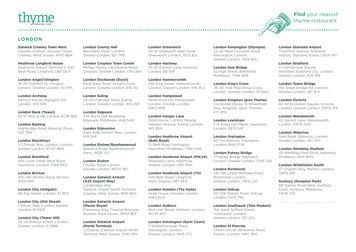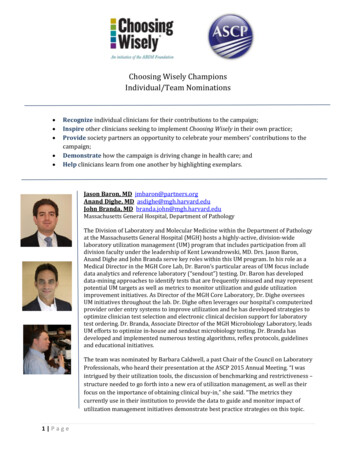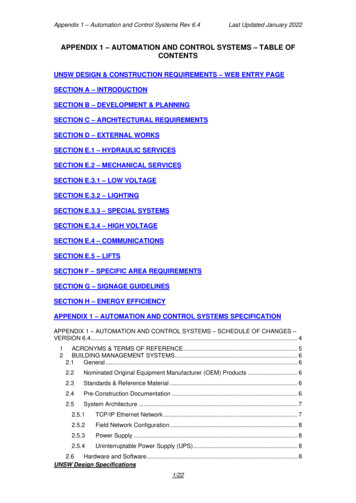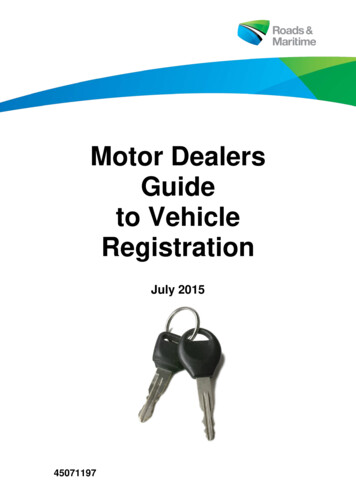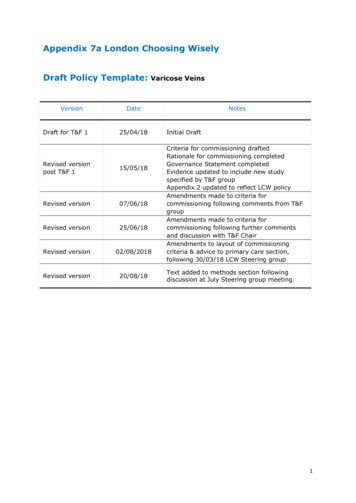
Transcription
Appendix 7a London Choosing WiselyDraft Policy Template:VersionDraft for T&F 1Varicose VeinsDate25/04/18Revised versionpost T&F 115/05/18Revised version07/06/18Revised version25/06/18Revised version02/08/2018Revised version20/08/18NotesInitial DraftCriteria for commissioning draftedRationale for commissioning completedGovernance Statement completedEvidence updated to include new studyspecified by T&F groupAppendix 2 updated to reflect LCW policyAmendments made to criteria forcommissioning following comments from T&FgroupAmendments made to criteria forcommissioning following further commentsand discussion with T&F ChairAmendments to layout of commissioningcriteria & advice to primary care section,following 30/03/18 LCW Steering groupText added to methods section followingdiscussion at July Steering group meeting.1
COMMISSIONING STATEMENTInterventionVaricose VeinsDate IssuedDates of ReviewThis policy only relates to adults over the age of 18 and does not apply topregnant women.This policy does not cover haemorrhage of varicose veins which is amedical emergency and should be treated accordingly.Clinical DescriptionNo visible or palpable varicoseveins*Visible telangiectasia orreticular veinsVisible or palpable varicoseveins:Commissioning decisionTreatment NOT fundedTreatment is funded only if the criteria inbox 1 OR 2 are met:1) One documented episode of superficialthrombophlebitis above the knee(referred urgently) or two documentedepisodes of superficial thrombophlebitisbelow the knee.Pan-LondonCommissioningRecommendation2) Swelling (oedema) due to varicoseveins, above the ankle in the affectedleg.ANDPatient experiences severe dailysymptoms (such as pain, heaviness,soreness or burning) that affectactivities of daily living.Overview – fulldetails within policydocumentSkin damage due to varicoseveins e.g. varicose eczema,lipodermatosclerosisHealed venous leg ulcer(a break in the skin below theknee taking more than 2 weeksto heal)Treatment will be fundedActive venous leg ulcer(a break in the skin below theknee not healed within 2weeks)Prepared By* Identified through diagnostic tests but not causing symptomsLondon Choosing Wisely, Commissioned by NHSEApproved ByDate ApprovedVaricose Veins Task& Finish Group,London Choosing25/06/2018Notes2
WiselyLCW Steering Board02/10/20183
Main Policy DocumentPolicy StatementLondon Choosing Wisely (LCW) was commissioned to carry out this work on behalf of allLondon Clinical Commissioning Groups (CCGs), in order to promote equitable access tocertain treatments and the cost-effective use of healthcare resources. All London CCGswill commission the treatment of varicose veins in accordance with the criteria outlinedin this document.In creating this policy, LCW convened a task and finish group focused on developing thispolicy and has reviewed this clinical condition and the evidence supporting treatmentleading to this commissioning decision.1. IntroductionVaricose veins are common and can affect up to 35% of the population. Whilst in somethese are asymptomatic, in others they cause symptoms that adversely affect quality oflife (such as pain or lower leg swelling) and less frequently lead to sequelae includingskin changes in up to 10% (venous eczema, ulceration) and bleeding in around 3% ofcases. Varicose veins are often unsightly and patients sometimes request interventionfor cosmetic reasons alone. All London CCGs have published commissioning policiesregarding varicose veins and are broadly similar in not routinely commissioningintervention for solely cosmetic reasons. The existing policies differ in the criteria underwhich varicose veins would be treated. This pan-London policy serves to standardise thecriteria for commissioning the treatment of varicose veins in secondary care.This policy does not cover haemorrhage of varicose veins which is a medicalemergency and should be treated accordingly.2. Key DefinitionsVaricose Veins: These are dilated, often palpable veins under the skin with reversedblood flow. They are most commonly found in the legs. They are common and can besymptomatic or asymptomatic.Endothermal Ablation: Energy from a laser (Endovenous Laser Ablation, EVLA) or highfrequency radio waves (Radiofrequency Ablation, RFA) is used to seal the affected veins.Foam Sclerotherapy: Foam is injected into the vein under ultrasound (Ultrasound GuidedFoam Sclerotherapy, UGFS) which scars the vein and seals it closed.Ligation & Stripping Surgery: A surgical procedure is undertaken to tie off the affectedvein in the leg and then remove it.3. Aims & Objectives To reduce unwarranted variation in access to treatment of varicose veinsTo ensure that the treatment of varicose veins is commissioned where there isacceptable evidence of clinical benefit and cost-effectivenessTo promote the cost-effective use of healthcare resources4
4. Criteria for commissioning (inc. exclusions)This policy only relates to adults over the age of 18 and does not apply to pregnantwomen.This policy does not cover haemorrhage of varicose veins which is a medicalemergency and should be treated accordingly.In commissioning interventions for varicose veins, the following classification should beapplied at both referral and treatment stage.Clinical DescriptionCEAPScoreNo visible or palpablevaricose veins*C0Visible telangiectasia orreticular veinsC1Visible or palpable varicoseveinsC2 or C3Commissioning decisionTreatment NOT fundedTreatment is funded only if the criteria inbox 1 OR 2 are met:1. One documented episode of superficialthrombophlebitis above the knee(referred urgently) or two documentedepisodes of superficial thrombophlebitisbelow the knee.2. Swelling (oedema) due to varicoseveins, above the ankle in the affectedleg.ANDPatient experiences severe dailysymptoms (such as pain, heaviness,soreness or burning) that affectactivities of daily living.Skin damage due to varicoseveins e.g. varicose eczema,lipodermatosclerosisC4Healed venous leg ulcer(a break in the skin belowthe knee taking more than 2weeks to heal)C5Active venous leg ulcer(a break in the skin belowthe knee not healed within 2weeks)C6Treatment will be funded* Identified through diagnostic tests but not causing symptomsWhen treatment is funded according to the above classification the following applieswithin secondary care:5
Duplex Doppler ultrasound must be performed to confirm diagnosis and planappropriate treatmentTreatment will be funded according to the following hierarchy:1. Offer endothermal ablation2. If endothermal ablation is deemed clinically unsuitable, offer ultrasound guidedfoam sclerotherapy3. If ultrasound guided foam sclerotherapy is deemed clinically unsuitable, offersurgeryAdvice to Primary Care PractitionersGive people who present with varicose veins information that includes: An explanation of what varicose veins are.Possible causes of varicose veins.The likelihood of progression and possible complications, including deep veinthrombosis, skin changes, leg ulcers, bleeding and thrombophlebitis. Address anymisconceptions the person may have about the risks of developing complications.Treatment options, including symptom relief, an overview of interventionaltreatments and the role of compression.Do not offer compression hosiery to treat varicose veins unless interventional treatmentis unsuitable.The following lifestyle advice should be offered to all patients with varicose veins: Weight loss (if BMI 30)Light to moderate physical exerciseSmoking cessationTreatment will NOT be funded in the following circumstances:1. Patients with no symptoms or skin changes associated with venous disease2. Patients whose concerns are cosmetic including telangiectasia and reticular veins3. Patients with mild symptoms including itch, ache, mild swelling, minor changes ofskin eczema and haemosiderosis4. Pregnant women presenting with varicose vein should be given information on theeffect of pregnancy on varicose veins. Interventional treatment for varicose veinsduring pregnancy should not be carried out other than in exceptional circumstances.Compression hosiery should be considered for symptom relief of leg swellingassociated with varicose veins during pregnancy.5. Evidence SummaryThe full evidence review can be found in Appendix 1, with a summary of findingsincluded.6
6. Rationale behind Policy StatementsIn drafting this commissioning policy, the Task and Finish Group considered the evidencepresented, the current position of CCGs both within and outside of London, and theirclinical experience.The Task and Finish group noted that whilst there is some high quality evidence relatingto varicose veins, this is mostly focused on the specific efficacy of treatments and not onwhen to treat patients, the key focus of the commissioning policy.The Task and Finish group noted that there is no evidence supporting treatment forthose in CEAP grades 0-1 as this would constitute purely cosmetic treatment. It was alsonoted that for CEAP grades 4-6, the more severe end of the spectrum, there was strongevidence to support treatment of varicose veins and this is in alignment with NICEguidelines and many other CCG policies. The Task and Finish group mostly debated CEAPgrades 2-3 as this requires most clinical judgement. The group concluded that patientswith CEAP of 2 or 3 that meet a number of additional criteria would also be eligible fortreatment. This is in alignment with the NICE guidelines.The group also reviewed the range of scoring systems that exists for varicose veins andnoted that none of these are fully suited to be used as commissioning criteria and theyare mostly used within research. The group noted that the ‘C’ element of the CEAPclassification is broadly most frequently used and is easiest to apply as it gives objectiveclinical criteria to define stage of varicose vein disease. The group has added additionalquality of life criteria around CEAP stages 2 and 3 to make this scale more fit forpurpose, and has opted to use clinical descriptions primarily rather than purely refer toCEAP criteria as these are less well known in primary care.The Task and Finish Group have opted to commission treatment modalities in line withNICE guidelines. There was no additional evidence to suggest a different treatmentoption should be first line and surgery still represents the last line of treatment. Thegroup noted that new treatments using glue are staring to evolve but do not yet have astrong evidence base and so should not yet feature in the policy, but will likely be addedin a future update.In addition, the Task and Finish Group discussed whether a reference should be made totreat one leg or both legs in the same procedure but it was agreed that there should notbe a reference made within the commissioning policy as there are multiple factors thatimpact on this decision, that should be clinically led.7. Adherence to NICE GuidelinesThis policy adheres to NICE Guideline CG168 – Management of Varicose Veins.8. Codes for proceduresThe following OPCS Codes are covered under this policy. This list is notexhaustive and can be added to at CCG level during implementation of policy.OPCS4L831Crossover graft of saphenous vein7
OPCS4L832Subfascial ligation of perforating vein of legOPCS4L838Other specified other operations for venous insufficiencyOPCS4L839Unspecified other operations for venous insufficiencyOPCS4L841Combined operations on primary long saphenous veinOPCS4L842Combined operations on primary short saphenous veinOPCS4L843Combined operations on primary long and short saphenous veinOPCS4L844Combined operations on recurrent long saphenous veinOPCS4L845Combined operations on recurrent short saphenous veinOPCS4L846Combined operations on recurrent long and short saphenous veinOPCS4L848Other specified combined operations on varicose vein of legOPCS4L849Unspecified combined operations on varicose vein of legOPCS4L851Ligation of long saphenous veinOPCS4L852Ligation of short saphenous veinOPCS4L853Ligation of recurrent varicose vein of legOPCS4L858Other specified ligation of varicose vein of legOPCS4L859Unspecified ligation of varicose vein of legOPCS4L861Injection of sclerosing substance into varicose vein of leg NECOPCS4L862Ultrasound guided foam sclerotherapy for varicose vein of legOPCS4L863Injection of glue into varicose vein of legOPCS4L868Other specified injection into varicose vein of legOPCS4L869Unspecified injection into varicose vein of legOPCS4L871Stripping of long saphenous veinOPCS4L872Stripping of short saphenous veinOPCS4L873Stripping of varicose vein of leg NECOPCS4L874Avulsion of varicose vein of legOPCS4L875Local excision of varicose vein of legOPCS4L876Incision of varicose vein of legOPCS4L877Transilluminated powered phlebectomy of varicose vein of legOPCS4L878Other specified other operations on varicose vein of legOPCS4L879Unspecified other operations on varicose vein of legOPCS4L881Percutaneous transluminal laser ablation of long saphenous veinOPCS4L882Radiofrequency ablation of varicose vein of legOPCS4L883Percutaneous transluminal laser ablation of varicose vein of leg NECOPCS4L888Other specified transluminal operations on varicose vein of legOPCS4L889Unspecified transluminal operations on varicose vein of legFor the following ICD-10 codes:With the following ICD-10 diagnosis code(s):I83.0Varicose veins of lower extremities with ulcerI83.1Varicose veins of the lower extremities with inflammation or specified as inflamed stasisdermatitis NOSI83.2Varicose veins of the lower extremities with both ulcer and inflammation8
I83.9Varicose veins of the lower extremities without ulcer or inflammationExceptions (ICD-10); the following in a primary or secondary diagnostic position:O22.0Varicose veins of the lower extremity in pregnancyO87.8Other venous complications in the pureperiumEquality & Equity StatementThe Equality and Equity Assessments for this policy will be undertaken at CCG level.Please contact the relevant London CCG for further details of their Equality ImpactAssessment.Governance statementIn mid-2017, London’s CCG Chief Officers supported a pan London programme to ensureequitable treatment access for all Londoners that is consistent, clinically appropriate andbased on robust evidence that supports improved patient outcomes for certaintreatments across London.NHS England (London) commissioned Healthy London Partnership (HLP) to facilitate theprogramme management and communications work of the programme, known as‘London Choosing Wisely’. A London Choosing Wisely Steering Group was formed,chaired by the NHSE (London) Medical Director, Dr Vin Diwakar, and included clinicalleaders representing each sustainability and transformation partnership (STP), theclinical leads appointed to the review of each area of care, patient representatives, andpublic health experts.The London Choosing Wisely programme specifically looked at the following eightprocedures: the surgical removal of benign skin lesions; hip arthroplasty; kneearthroplasty; knee arthroscopy; interventional treatments for back pain; varicose veinprocedures; shoulder decompression and cataract surgery.Six Task and Finish Groups were established to review the evidence and draft the policydocumentation for each of the eight identified procedures (with hip and knee policiesbeing considered together). Each group was chaired by a primary care clinical lead, whoalso sat on the Steering Group. All groups included primary and secondary careclinicians and patient representatives from across the London region and were supportedby independent public health experts. Upon consideration of the evidence, the Task andFinish Group drafted and agreed the commissioning policy which was subsequentlypresented to the Steering Group for approval. The Steering Group’s role was to ensurethat a robust and rigorous review process had been carried out and to agree a final draftfor each pan London policy.9
Appendix 1 – Full Evidence ReviewLondon Choosing WiselyGuidance and Evidence Review Summary:VersionDateVaricose VeinsNotesDraft for PH Lead25/04/18Initial DraftDraft for T&F 127/04/18Public health amendments madeEvidence strengthened where possible to clarifyclinical significance of findings.Revised versionpost T&F 115/05/18Additional evidence added25/06/18Based on feedback from earlier policies, tomake main policy less lengthyRevised to includeevidence summaryhereAmendedAmended finalversion31/07/201820/08/18To include details of search terms from searchstrategy document, following LCW steeringgroup meeting of 30/07/18Text added to methods section followingdiscussion at July Steering group meeting.10
1.0 Introduction(What?)This guidance and evidence review will focus on treatments for varicoseveins and will include endothermal ablation, foam sclerotherapy andsurgery. The review does not seek to define the efficacy of each type oftreatment in detail, rather to determine criteria to inform decisionsabout if or when to consider treatment, given that varicose veins occurcommonly and may be asymptomatic or minimally symptomatic.This review does not cover haemorrhage of varicose veinswhich is a medical emergency and should be treatedaccordingly.A list of ICD-10 and OPCS codes relevant to this guidance and evidencereview (and ultimately a commissioning policy) are included inAppendix 3. This list is not exhaustive and can be added to at CCG levelduring implementation of a policy. It is noted that issues around codingof diagnoses and procedures can affect adherence to commissioningpolicies but this does not negate the need for a policy to state the ICD10 and OPCS codes included.(Who for?)The review includes the adult population only (aged 18 and over).(Why is theprocedurecarried out?)Varicose veins are common and can affect up to 35% of the population.Whilst in some these are asymptomatic, in others they cause symptomsthat adversely affect quality of life (such as pain or lower leg swelling)and less frequently lead to sequelae including skin changes in up to10% (venous eczema, ulceration) and bleeding in around 3% of cases.Varicose veins are often unsightly and patients sometimes requestintervention for cosmetic reasons alone.(Why anissue?)Most London CCGs have a commissioning policy relating to thetreatment of varicose veins. These are similar and no CCG routinelyfunds treatment of varicose veins for purely cosmetic reasons.However, the criteria whereby treatment would be funded, and whichtreatments are funded differ between CCGs. Barking, Havering andRedbridge (BHR) do not routinely fund the treatment of varicose veinsat all.(Who elsedoes what?)See Appendix 2 for a detailed table of current CCG policies relating tothe treatment of varicose veins. No London CCGs routinely commissiontreatment of varicose veins for cosmetic reasons. CCGs onlycommission the procedures if certain criteria are met, but these differbetween CCGs. For example, some CCGs require that a duplexultrasound has shown the extent of truncal reflux before funding whilstother CCGs do not state this criterion. Some CCGs stipulate that foamsclerotherapy is not routinely funded whilst others leave the “choice ofsurgical intervention at the discretion of the clinician”. Similarly, someCCGs state a requirement for patients to cease smoking ahead offunding varicose vein treatment whilst others do not state this.Through the commissioning positions of the London CCGs are broadlysimilar, there is potential for patients to not be receiving equal accessto treatments across London due to the differing thresholds required toachieve funding.11
2.0 Search strategy:Core search questions:1)2)3)4)5)What are the key clinical criteria (e.g. eczema, ulcers, infection) for which theevidence shows value treating the varicose vein?Does the evidence describe specific parameters of these criteria wheretherapeutic value is achieved? (e.g. length of time for ulcer to heal, number ofepisodes of thrombophlebitis)Are there any comorbid conditions for which the evidence shows value treatingthe varicose vein?Does the evidence provide an appropriate scoring system for severity of varicoseveins within clinical practice?Is there an evidence-based treatment hierarchy and if so, what is this? E.g.endothermal ablation, followed by sclerotherapy?Search Terms:Varicose veins, varicose veins scoring, long saphenous vein, short saphenous vein, greatsaphenous vein.In addition the following interventions will be searched: endothermal ablation, foamsclerotherapy, ligation, stripping, laser ablation.The evidence review will not, in detail, review the efficacy of these interventions, but willseek to define when intervention is indicated.2.1 Search MethodIn line with the scope agreed for this work, the literature review was intended to focuson collating information across existing CCG policies and reviewing approximately 5research papers (level 1 policy group). An initial search was undertaken of nationalguidelines and CCG policies across London. There are NICE guidelines (1) on themanagement of varicose veins, published in 2013 and reviewed in 2016. As perAppendix 2, most London CCGs commission varicose vein treatment broadly inaccordance with these guidelines and cite the NICE guidelines as the source of evidence.We have identified the key literature providing evidence to this NICE guidance andincluded these in the review below. To align the above research questions and with thescope of the LCW Programme we have focused on the following chapters from the NICEevidence base:Core search question1)2)3)What are the key clinical criteria (e.g.eczema, ulcers, infection) for which theevidence shows value treating thevaricose vein?Does the evidence describe specificparameters of these criteria wheretherapeutic value is achieved? (e.g.length of time for ulcer to heal, number ofepisodes of thrombophlebitis)Are there any comorbid conditions thatwould indicate varicose vein intervention?Related chapter from NICEevidence baseC.2.1 Factors associated with diseaseprogressionC.2.2 Factors associated withtreatment successC.3.2 Duplex vs. No duplex prior tointerventional treatment12
4)Does the evidence document anappropriate scoring system for severity ofvaricose veins within clinical practice?Nil directly related5)Does the evidence document the mostappropriate treatment pathway i.e.endothermal ablation, followed bysclerotherapy?C.4.1 Conservative treatment vs. notreatmentC.4.2 Compression Vs interventionaltreatmentC.5.1 Stripping surgery vs. foamsclerotherapyC.5.2 Stripping surgery vs endothermalablationC.5.3 Foam sclerotherapy vsendothermal ablationThis evidence has been graded according to the following table, with Level 1 evidencebeing of highest quality. Where level 1 evidence exists, we have not reviewed lowerquality evidence.Level 1Meta-analyses, systematic reviews of randomised controlled trialsLevel 2Randomised controlled trialsLevel 3Case-control or cohort studiesLevel 4Non-analytic studies e.g. case reports, case seriesLevel 5Expert opinionWhere a core search question could not be answered using the evidence within the NICEguidelines, the following databases were searched. In addition, these databases weresearched for evidence subsequent to the inclusion period for the NICE guidelines: NHS EvidenceCochrane LibraryPubMedBritish Medical Journal (BMJ) including BMJ Best Practice and BMJ Clinical EvidenceRoyal College of SurgeonsVascular Surgery Society2.2 Inclusion / Exclusion Criteria:Inclusion:Unlimited date rangeEvidence relating to adults onlyExclusion:Non English Language papersEvidence relating to children13
3.0 Summary of findingsThe following represents the key evidence used to form the NICE Guidelines on varicoseveins.Related chapter from NICEevidence baseSummary of highest grade of evidencefoundLevel1Level2C.2.1 Factors associated withdisease progressionLevel3Level4Level5 C.2.2 Factors associated withtreatment successC.3.2 Duplex vs. No duplex prior tointerventional treatment C.4.1 Compression (conservative)treatment vs. no treatmentC.4.2 Compression (conservative)vs. interventional treatmentC.5.1 Stripping surgery vs. foamsclerotherapyC.5.2 Stripping surgery vsendothermal ablationC.5.3 Foam sclerotherapy vsendothermal ablationThe following level of evidence was identified within the NICE 2016 guidelinessurveillance. None of the new evidence had an impact on the NICE guidelines.Related chapter from NICEevidence baseC.2.1 Factors associated withdisease progressionC.2.2 Factors associated withtreatment successC.3.2 Duplex vs. No duplex prior tointerventional treatmentC.4.1 Compression (conservative)treatment vs. no treatmentC.4.2 Compression (conservative)vs. interventional treatmentC.5.1 Stripping surgery vs. foamsclerotherapyC.5.2 Stripping surgery vsendothermal ablationSummary of highest grade of evidencefound between 2013-2016Level1Level2Level3Level4Level5No additional evidence was added during theNICE Guideline review pertaining to thesechapters 14
C.5.3 Foam sclerotherapy vsendothermal ablation The following evidence level has been identified since the 2016 publication of the NICEGuideline surveillance.Summary of highest grade of evidencefound between 2013-2016Level1Additional evidence post-2016NICE guideline surveillanceLevel2Level3Level4Level5 Classification of FindingsCEAP Classification: Clinical Severity, Aetiology, Anatomical Location, PathophysiologyThere are a number of grading systems used to group patients with varicose veinstogether, including the CEAP classification. Not all aspects of the classifier are used,however most evidence uses C1-6 as a grading system and thus a measure of outcomesin varicose veins treatment. Further scoring systems are described in search question 4below.C0 No visible or palpable varicose veinsC1 Telangiectasia / reticular veinsC2 Visible/palpable varicose veins (symptomatic or asymptomatic)C3 Swelling (oedema) due to varicose veins (venous oedema)C4 Skin damage due to varicose veins (e.g. varicose eczema, atrophie blanche)C5 Healed venous leg ulcerC6 Active venous leg ulcerSimilar to the NICE guidelines, this review will refer to the CEAP classification as adescriptor for stasis or progression of varicose vein disease to match outcomes describedin the RCTs. CEAP was not designed to be used as a measure of clinical change, or toprovide referral criteria and thus may not represent the best way of measuring thecondition. This concern is also documented within the NICE guideline (1).Findings1. What are the key clinical criteria (e.g. eczema, ulcers, infection) for whichthe evidence shows value treating the varicose vein?2. Does the evidence describe specific parameters of these criteria wheretherapeutic value is achieved? (e.g. length of time for ulcer to heal, numberof episodes of thrombophlebitis)3. Are there any comorbid conditions that would indicate varicose veinintervention?The first three search questions have been grouped into one summary of findings asthese are mostly addressed by the same evidence and serve to answer the samequestion – when should varicose veins be treated?15
The 2013 NICE Clinical guidelines (1) states that patients with the following criteriashould be referred to a vascular service for consideration of treatment: Symptomatic primary or symptomatic recurrent varicose veins. (Symptomatic isdescribed as associated with troublesome lower limb symptoms such as pain,swelling, heaviness, or itching, typically linked to periods of standing)Lower‑ limb skin changes, such as pigmentation or eczema, thought to be caused bychronic venous insufficiencySuperficial vein thrombosis (characterised by the appearance of hard, painful veins)and suspected venous incompetence.A venous leg ulcer (a break in the skin below the knee that has not healed within 2weeks).A healed venous leg ulcerIn patients who fulfil these criteria, the guidelines recommend treatment if a duplexultrasound confirms the diagnosis of varicose veins with truncal reflux (1).There is no level 1 or level 2 evidence to answer this research question or support theNICE guideline. The NICE guideline was formed from a number of level 3, case controlstudies. One study (8) comparing 120 subjects with varicose veins and open or healedvenous leg ulcers, with 120 control subjects with varicose veins and no history of venousulcers showed that patients with skin changes (including lipodermatosclerosis (odds ratio[OR] 8.90, 95% confidence interval [CI] 1.44-54.8), corona phlebectatica (OR 4.52,95% CI 1.81-11.3) and eczema (OR 2.87, 95% CI 1.12-7.07)) of chronic venous diseaseand deep vein incompetence were most at risk of future ulceration (i.e. moving from C24 to C5-6). The same study also found the risk to be higher in patients who are obese(higher BMI (OR 1.08, 95% CI 1.01-1.15)), smoke, have restricted ankle movement andreduced calf muscle pump function.A historical cohort study (9) with 290 participants (n 1,978 in total, but 290 with C2disease at baseline) in Germany also found obesity to be a main risk factor forprogression of vascular disease (from C2 to C3-6), alongside age and a subjective“swelling feeling” in the legs lasting 4 weeks at baseline. This was also true for asubjective feeling of “leg tension” and “leg heaviness” lasting 4 weeks at baseline. Painduring prolonged walking and itching in the 4 weeks before baseline were not associatedwith disease progression however these last conclusions were highly uncertain. The firstcriterion in the NICE guideline ‘Symptomatic primary or symptomatic recurrent varicoseveins’ is subject to interpretation. A footnote is included by NICE which describes theseas “troublesome lower limb symptoms (typically pain, aching, discomfort, swelling,heaviness and itching).” (1) The evidence for this criterion as stated above is of lowquality.A case-control study (10) describes most factors typically associated with worseningchronic venous disease are in fact due to this popul
This policy does not cover haemorrhage of varicose veins which is a medical emergency and should be treated accordingly. 2. Key Definitions Varicose Veins: These are dilated, often palpable veins under the skin with reversed . Pregnant women presenting with varicose vein should be given information on the effect of pregnancy on varicose veins .
